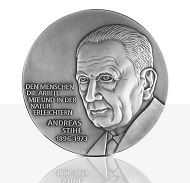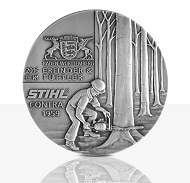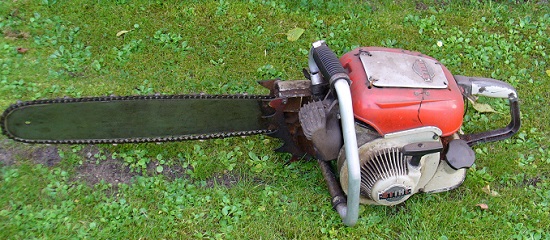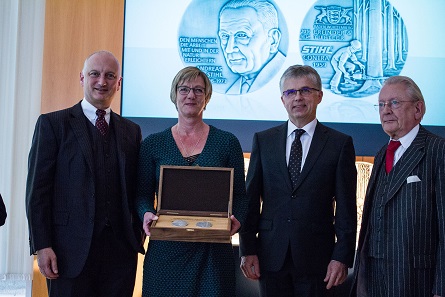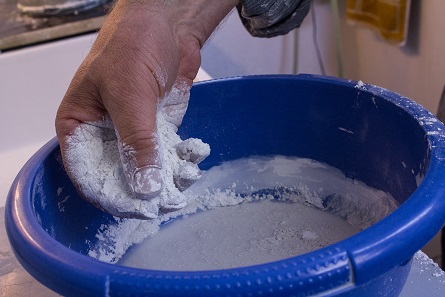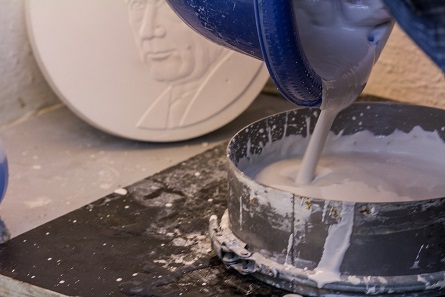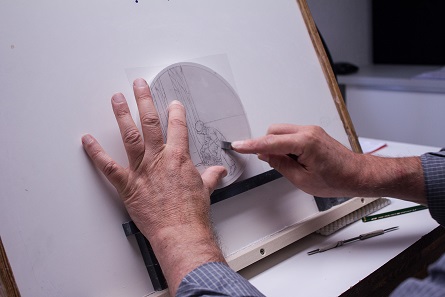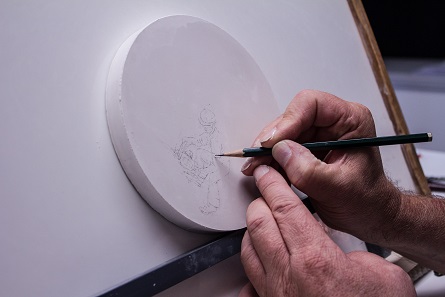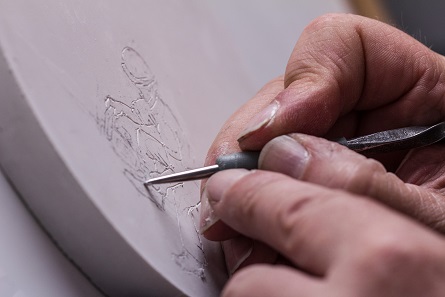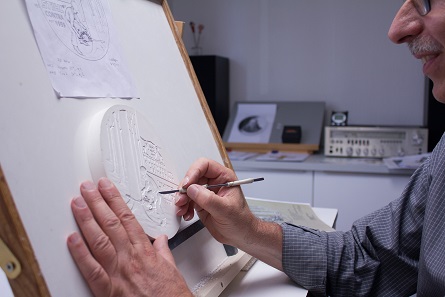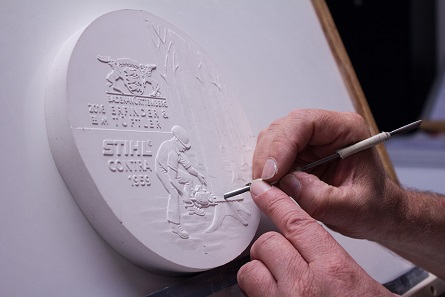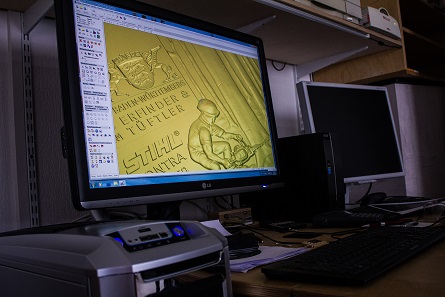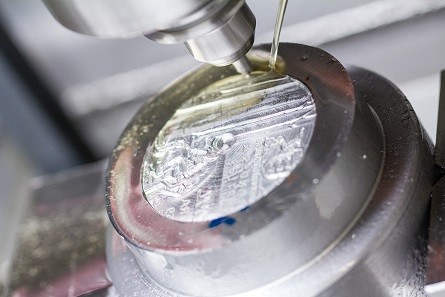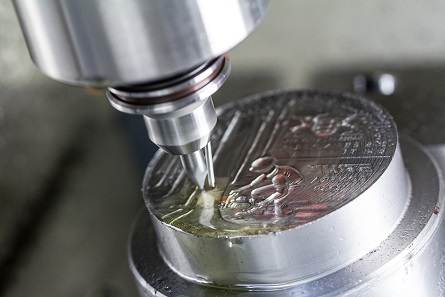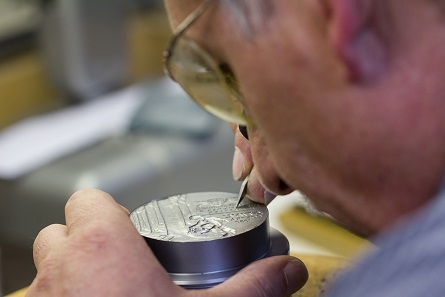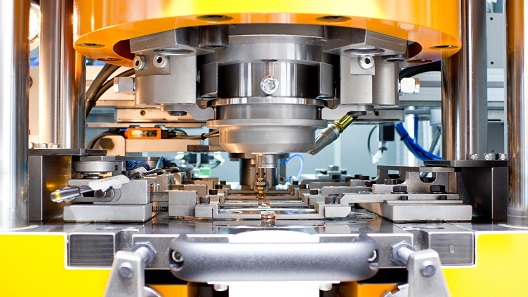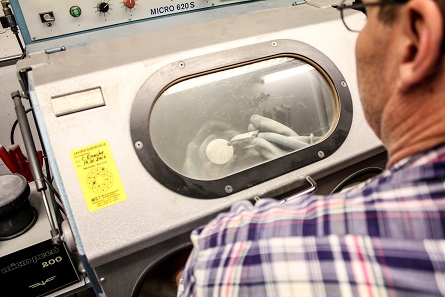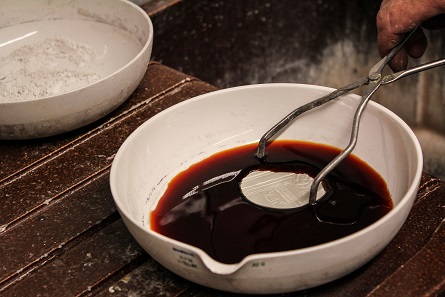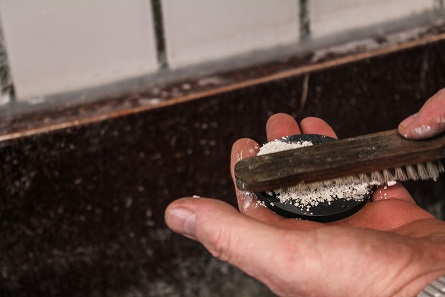by Ursula Kampmann
translated by Annika Backe
November 3, 2016 – For ten years now, the State Mints of Baden-Württemberg release their successful “Inventors from Baden-Württemberg” series. World-renowned creators like Ferdinand Porsche, Margarete Steiff, and Gottlieb Daimler are conjoined with the one honored by the 2016 medal, …
The latest medal of the “Inventors from Baden-Württemberg” series, dating from 2016. Photo: State Mints of Baden-Württemberg.
… the “Father of the Chainsaw”, Andreas Stihl.
With a weight of “only” 12 kilograms, the Stihl Contra became the chainsaw which gave the motorization of the work in the woods its break. The Stihl Contra is shown on the reverse of the medal. Photo: Guido Habers / Wikipedia CC 2.5
Andreas Stihl developed his first chainsaw in 1926. It was designed to “make people‘s work with and in nature easier”. The idea to not bring the tree to the saw mill but, rather, a small saw mill to the tree, revolutionized lumber industry. With the classic Stihl Contra, introduced to the general public in 1959, Stihl developed his first gearless chainsaw. It turned out to be a success story. In less than two years, as many as 200,000 examples were manufactured. In 1961, the company had to charter cargo planes in order to satisfy the incredible demand in Canada and the U.S.
Finance Minister of the State of Baden-Württemberg, Edith Sitzmann MdL, and Mint Director, Dr. Peter Huber, gifting the representatives of Andreas Stihl AG with the art medal. From left to right: Dr. Nikolas Stihl, supervisory and advisory board chairman and grandson of the company’s founder, Edith Sitzmann, Dr. Peter Huber, Hans Peter Stihl, former head of the company and son of Andreas Stihl. Photo: State Mints of Baden-Württemberg.
Still family-run, the Andreas Stihl AG currently has more than 14,000 employees which helped achieving a turnover of 3.25 billion euros in 2015. In terms of chainsaws, Stihl is the global market leader.
Design drawing by Prof. Ulrich Böhme. Photo: State Mints of Baden-Württemberg.
The design for the Andreas Stihl medal was created in close consultation with the representatives of his company who made sure that the woodworker on the reverse not only uses the chainsaw in the right way but has an ergonomically correct position, too. The design was created by Prof. Ulrich Böhme who is also the designer of the other medals of this series.
The design for the Andreas Stihl medal was created in close consultation with the representatives of his company who made sure that the woodworker on the reverse not only uses the chainsaw in the right way but has an ergonomically correct position, too. The design was created by Prof. Ulrich Böhme who is also the designer of the other medals of this series.
In line with good old handicraft tradition, the first step of the high-relief medals of the “Inventors from Baden-Württemberg” series is to realize the design in a plaster model first. Here you can see how the required material is prepared.
This workpiece can’t be bought. The engraver has to cast it from plaster himself. Photo: State Mints of Baden-Württemberg.
Every medalist produces his own workpieces into which he then cuts the motif.
The design is transferred onto the plaster. Photo: State Mints of Baden-Württemberg.
Responsible for the 3D realization of the design is engraver Werner Mebert. He has collaborated with Ulrich Böhme for all medals of the “Inventors from Baden-Württemberg” series. Here, he is shown transferring the design’s contours onto the plaster model – mirror-inverted, of course.
The pencil is used for filling in losses. Photo: State Mints of Baden-Württemberg.
Using a pencil, Werner Mebert carefully fills in losses after tracing.
The contours are emphasized. Photo: State Mints of Baden-Württemberg.
Afterwards, the contours are emphasized. To this effect, Werner Mebert uses his scriber which, as all other tools of his, he has made himself.
To the engraver, the design is crucial. Photo: State Mints of Baden-Württemberg.
Based on the design, the engraver produces a concave model which corresponds to the later die.
The convex model, the basis of the production of dies. Photo: State Mints of Baden-Württemberg.
The concave plaster model is cast, thus generating a convex model which corresponds to the later high-relief medal. It is hardly necessary to mention that some reworking is done as late as this stage. Using state-of-the-art laser technology, this model is converted into an image file in the highest resolution possible.
Intermediate stage on the computer. Photo: State Mints of Baden-Württemberg.
With a program specifically developed for die production, the file is edited. It is possible to work on the smaller portions in great detail, and much more finely than can be done by hand.
A die is produced on the basis of the file. Photo: State Mints of Baden-Württemberg.
Then, the data file is converted into a die in several working steps. In a first run, the basic working is done, …
It takes several steps to make a die. Photo: State Mints of Baden-Württemberg.
… supplemented by the precision work in a second step. The job, however, is still far from finished.
To create a perfect die, ancient handicraft is needed once again. Photo: State Mints of Baden-Württemberg.
The die is reworked manually, smoothened and, of course, its most delicate details are optimized also by hand.
The minting process with eight hubs of up to 450 tons is achieved by an oil-hydraulic press by Sack & Kiesselbach. Photo: State Mints of Baden-Württemberg.
It is this die – not the original, of course, but an identical cast – that is used in the minting process. The extremely high relief of the silver and bronze variants of the art medal requires particular care. The issues are produced, with eight blows with a pressure of up to 450 tons, with an oil-hydraulic press by Sack & Kiesselbach.
To achieve a perfect patina, the surface has to be roughened first. Photo: State Mints of Baden-Württemberg.
The work on the art medal involves yet another step. To create the fine patina, the surface is sandblasted and thus roughened.
Pickling is next. Photo: State Mints of Baden-Württemberg.
The medal is now ready for the pickle, giving it the fine patina.
The superfluous pickling solution is removed. Photo: State Mints of Baden-Württemberg.
After this bath, the medal exhibits a dark color. With a brush and pumice stone paste, parts of the metal surface are cleaned from the pickling solution to the effect that the patina emphasizes the high relief in the best way possible.
The 2016 Andreas Stihl Medal of the “Inventors from Baden-Württemberg” series. Photo: State Mints of Baden-Württemberg.
Now, the Andreas Stihl art medal is finally finished.
You can order the Andreas Stihl high-relief medal here.
More information on the history of Stihl is provided by this (German) brochure.
Even if somebody doesn’t need a chainsaw he might still know the Stihl calendar decorating the walls of thousands of garages throughout the world. If you want to know why, you can have a look at the hottest pictures from 40 years….
You can learn more about medal designer Ulrich Böhme on German Wikipedia.
We reported several times on the State Mints of Baden-Württemberg. You can take a tour around the Stuttgart Mint. And here, we visited the Karlsruhe Mint.
And that chainsaws put you in a good mode is proven by the song “Wirf die Motorsäge an” (translates as “Start the chainsaw!”) by the band “Erste Allgemeine Verunsicherung”.





